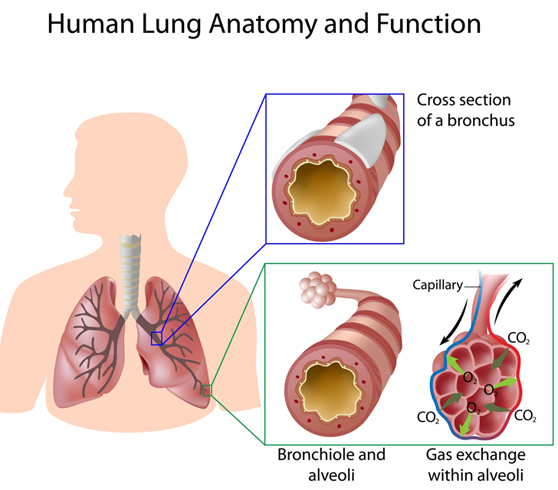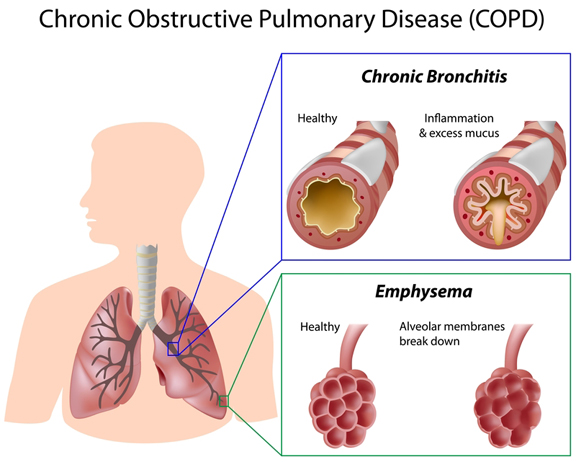Learn These Basic Health Facts About Lungs—and Breathe Easier
The lung diseases list is long, but the more facts about lungs you know, the more likely you are to keep them healthy.
You take about 20,000 breaths a day, which means your respiratory system never stops working. It also means that your lungs need to be as healthy as possible in order for you to breathe easily as you age. Knowing the key facts about lungs can help you make healthy decisions about smoking, exercise, and other lifestyle choices. And the more you learn about the life-threatening conditions that make up the lung diseases list, the more incentive you’ll have to keep your lungs in optimal health.
Facts About Lungs and How They Work
One of the most important facts about lungs and respiratory health is that every cell in your body needs oxygen to function. The only way to get oxygen to all of those cells is by breathing it in through your lungs.
Once in your lungs, oxygen moves into your bloodstream, where it is carried to the heart through the pulmonary vein. Once in the heart, oxygenated blood is eventually pumped out to the rest of the body. Yes, like your lungs, your heart never gets a vacation either.
Dispelling a Lung Myth
Among the common myths about lungs is the notion that they are primarily hollow—like balloons or bellows waiting to be filled with air before they empty themselves of all that oxygen. Instead, think of your lungs as sponges made up of a complex network of air passageways and blood vessels.
But unlike real sponges that are supposed to get wet and soggy, your lungs don’t do well when they’re too wet. For example, when you breathe in through your nose and mouth, air moves down your throat and into your trachea (or windpipe). It then divides into the bronchial tubes in the lungs, which divide into smaller airways called bronchioles. If any part of this airway system becomes clogged with mucus or becomes inflamed and swollen, breathing becomes harder.

The illustration here presents a cross section of the bronchiole and alveoli in our lungs. (© Alila07 | Dreamstime.com)
If you have pneumonia, one of the most serious items on the lung diseases list, little air sacs in the lungs (alveoli) can fill up with fluid, too. This not only makes it harder to breathe, but it makes it more difficult for oxygen to move into the bloodstream.
Respiratory Problems
Along with pneumonia, some of the most serious lung diseases are emphysema, COPD (chronic obstructive pulmonary disorder), and, of course, lung cancer. But many respiratory problems aren’t necessarily life-threatening conditions. Among them are a mild case of bronchitis (inflammation of the mucus membrane in the bronchioles) or occasional flare-ups of asthma (a spasm of one or more of the airways that extend from the trachea).

When Inflammation and excess mucus clog up bronchiole and alveoli in our lungs, the result is COPD. (© Alila07 | Dreamstime.com)
Bronchitis and asthma are treatable with medications, including those administered with an inhaler. If you’re an older adult who has never had asthma or allergies (another common but treatable respiratory challenge), you may find that you’re more susceptible to these conditions. The truth is, our lung function tends to diminish as we age. Because of this, we are more vulnerable to many respiratory problems. Emphysema, for instance, means the air sacs in the lungs are enlarged and damaged. This makes it difficult to breathe, as you might imagine.
Lung Disease Prevention
Now that you know more about how lungs function, you should know the most important preventive facts about lungs. And the most important one is… don’t smoke. If you do smoke, quit as soon as you can. Even if you’ve been smoking for most of your life, your lung function and circulatory health can improve once you kick the habit.
Understand that the average smoker has to try around a half-dozen times before quitting permanently. Today there are more medications and therapies designed to help smokers quit than ever before. Talk with your doctor about your options, and see what local support programs might be in your community. If you’re struggling to quit, you are certainly not alone.
The other important keys to better lung health include regular exercise. Your lungs are muscles, so give them a workout with aerobic exercise (brisk walking is fine) 30 to 40 minutes every day.
And make sure you see your doctor regularly for physical exams that include a good listen to your lungs and heart. Your doctor may notice something that doesn’t sound right with a stethoscope before you notice anything about your breathing. If you do start coughing or you feel anything unusual, such as shortness of breath or congestion in your lungs, don’t ignore these symptoms. They may be signs of a mild respiratory infection, but they also may be symptoms of a condition that needs your attention now.
Originally published in 2017, this post is regularly updated.


 What is a Pulse Oximeter?
What is a Pulse Oximeter?  Lung Detox or Lung Cleanse: Can You Clean Out Your Lungs Naturally?
Lung Detox or Lung Cleanse: Can You Clean Out Your Lungs Naturally?  Are There House Plants That Clean the Air?
Are There House Plants That Clean the Air? 
The lungs, located in the upper chest, are susceptible to a number of diseases, some that we cause ourselves via such habits as smoking cigarettes.
© Sebastian Kaulitzki | Dreamstime.com